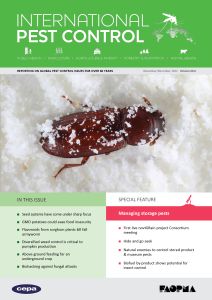A Biased View of Eco Bed Bug Exterminators Dc
A Biased View of Eco Bed Bug Exterminators Dc
Blog Article
A Biased View of Eco Bed Bug Exterminators Dc
Table of ContentsSome Known Details About Eco Bed Bug Exterminators Dc Eco Bed Bug Exterminators Dc Things To Know Before You BuyThe smart Trick of Eco Bed Bug Exterminators Dc That Nobody is Talking AboutThe Ultimate Guide To Eco Bed Bug Exterminators DcThe Greatest Guide To Eco Bed Bug Exterminators Dc
Since chemicals are hazardous, they are likewise potentially harmful to humans, pets, other microorganisms, and the environment. People who use pesticides or on a regular basis come in call with them have to understand the relative toxicity, prospective health results, and preventative actions to reduce exposure to the products they utilize. Risk, or threat, of utilizing pesticides is the capacity for injury, or the degree of risk entailed in utilizing a pesticide under a given collection of conditions.
Applicators can lessen or almost eliminate exposure-- and thus reduce risk-- by complying with the label guidelines, using personal safety clothing and tools (PPE), and managing the pesticide correctly. Even more than 95 percent of all pesticide direct exposures come from dermal exposure, mostly to the hands and lower arms. By using a set of unlined, chemical-resistant gloves, this kind of exposure can be virtually removed.
The damaging impacts that happen from a single direct exposure by any kind of route of entrance are described "severe impacts." The four courses of exposure are dermal (skin), breathing (lungs), oral (mouth), and the eyes. Severe toxicity is identified by examining the facial toxicity, breathing toxicity, and dental toxicity of examination animals.
Some Of Eco Bed Bug Exterminators Dc
Severe poisoning is gauged as the quantity or concentration of a toxicant-- the a.i.-- needed to kill half of the animals in a test population. This step is generally shared as the LD50 (dangerous dosage 50) or the LC50 (deadly concentration 50). Furthermore, the LD50 and LC50 worths are based on a single dose and are recorded in milligrams of pesticide per kilogram of body weight (mg/kg) of the guinea pig or in parts per million (ppm).
The lower the LD50 or LC50 worth of a pesticide item, the greater its poisoning to humans and pets. Chemicals with a high LD50 are the least hazardous to people if made use of according to the directions on the item label. The chronic toxicity of a pesticide is identified by subjecting guinea pig to long-term exposure to the energetic ingredient.
The chronic toxicity of a chemical is a lot more difficult than severe toxicity to figure out through research laboratory analysis. Products are classified on the basis of their family member severe poisoning (their LD50 or LC50 worths). Chemicals that are classified as very toxic (Toxicity Classification I) on the basis of either oral, facial, or inhalation poisoning have to have the signal words risk and POISON published in red with a skull and crossbones symbol prominently presented on the front panel of the plan tag.
The severe (solitary dosage) dental LD50 for chemical items in this team ranges from a trace quantity to 50 mg/kg. Exposure of a couple of drops of a material taken orally could be fatal to a 150-pound individual. https://www.easel.ly/browserEasel/14452085. Some pesticide items have just the signal word threat, which informs you absolutely nothing regarding the acute toxicity, just that the product can trigger severe eye damages or severe skin irritability
Everything about Eco Bed Bug Exterminators Dc
In this classification, the intense oral LD50 varieties from 50 to 500 mg/kg. A teaspoon useful content to an ounce of this product might be deadly to a 150-pound person (exterminator). Pesticide products categorized as either slightly toxic or fairly nontoxic (Poisoning Categories III and IV) are needed to have the signal word care on the chemical tag

See This Report about Eco Bed Bug Exterminators Dc
All pesticide toxicity values, worths the LD50, can be found on the product's Material Safety Data Safety and security (MSDS). Chemical tags and MSDS can be gotten from merchants or produces. On top of that, many products likewise know that can be located on the web. The signs and symptoms of pesticide poisoning can vary from a moderate skin inflammation to coma or perhaps fatality.
People also differ in their sensitivity to various levels of these chemicals. Some individuals may reveal no response to a direct exposure that might create serious ailment in others (how to get rid of bed bugs). Since of potential health concerns, chemical customers and trainers need to identify the usual signs and signs of chemical poisoning. The effects, or signs, of pesticide poisoning can be generally specified as either topical or systemic.
The smart Trick of Eco Bed Bug Exterminators Dc That Nobody is Talking About
Dermatitis, or swelling of the skin, is approved as the most generally reported topical effect related to pesticide direct exposure. Signs of dermatitis variety from reddening of the skin to rashes and/or blisters. Some people have a tendency to cough, wheeze, or sneeze when revealed to pesticide sprays. Some people respond to the strong odor and annoying results of oil extracts used as providers in chemical products.
This signs and symptom generally subsides within a few mins after a person is eliminated from the exposure to the toxic irritant. Nevertheless, a response to a chemical product that triggers a person not just to sneeze and cough however likewise to create serious acute respiratory system signs is most likely to be a real hypersensitivity or sensitive reaction.
Systemic impacts are fairly various from topical effects. They frequently happen away from the initial point of call as a result of the chemical being soaked up into and dispersed throughout the body.
Report this page